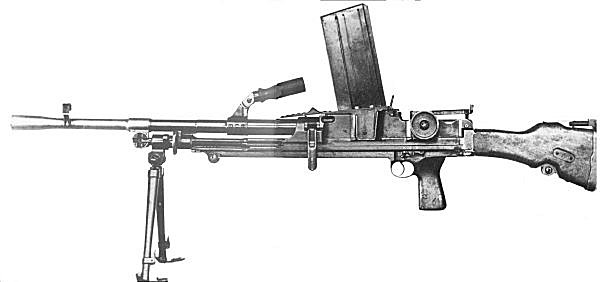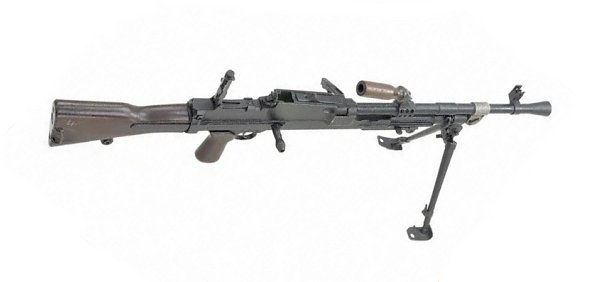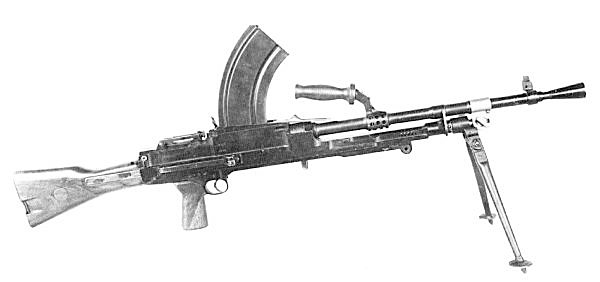During the first year of the Korean War, some CCF units used the .792mm Bren Mark I, captured from the Nationalist Chinese, as well as .303mm Brens probably captured from the Japanese, who had earlier taken them from British forces at Singapore and Hong Kong.
Properly designated as a Light Machine gun, the Bren was considered one of the finest such weapons developed in WWII. Gas-operated, its mechanical components are simple and easily understood; it can be stripped and assembled by a trained soldier in a very short time. There are only a few possible stoppages, and the Bren earned an enviable reputation for accuracy and reliability. The Chinese used the Bren much as US forces used our BAR, in support of squad-sized assaults and defense. The Mark I had an aperture rear sight controlled by a radial drum, with a shoulder support, and early models had a pistol grip beneath the butt for the non-firing hand. These augmentations went away quickly.
The Mark IV was standard United Kingdom issue during the KW, with a simplified butt design, leaf rear sight, shorter barrel, and was also lighter.
The following comments are from Sherro:
As a bit more info, the Red Chinese had quite a large quantity of 7.92mm Bren Guns made by Inglis in Canada. (That's 7.92mm German not 7.62mm NATO). They were mainly captured from the Nationalist Chinese.
A lot of their soldiers also used 7.92mm Mauser rifles, many manufactured by the Nationalists and also the Communists in their armouries. They had a penchant for German things, which wasn't a bad way to go. They also made lovely full auto and semi-auto Mauser Machine pistols in 7.63mmand 9mm.
It was a fairly simple matter for the British to change over to 7.62mm Nato in the 60s, all they did was change barrels, bolts and magazine wells and add a 30 round magazine. The bolts were almost identical to the 7.92mm bolts from Inglis.
The original BRNO weapons were also in 7.92mm, then the British altered them to use the .303 British Mk VII cartridge and a curved magazine to accomodate the rimmed cartridge. This was a curse and a source of feed checks and annoyance for soldiers who used them when the flanged rims on the .303 cartridges got into the wrong position overlapping behind the next cartridge in the magazine.
The following comments are from Brock Dittrick:
Please take note on your comments on the BREN MKI. The Chinese were also supplied with these LMG's during the WW2 by Canada. As well as the STEN. The Chinese Bren's made by John Inglis was in 7.62 and also had the CH serial number range like the Inglis Browning Hi Power's
You mention that they probably obtained them through Brit capture in Singapore etc,. Yes the BREN was captured no doubt in some quantity but not nearly as much as Lend Lease from Canada.
The STEN's are marked in Chinese on the mag well.
STEN MKII
Handy Gun Machine
Made In Canada
Here is a short history on the BREN as it pertains to the Chinese.
The British government purchased 189 Czech Zbv30 LMGs in 7.92 X 57 mm for 50 pounds sterling each for an engineering benchmarking study in Canada. These LMGs were copied and the initial production was some 13 000 units in 7.92 X 57 ( 8 MM Mauser) for the Nationalist Chinese government. In all approx 43 000 7.92 mm BRENs were manufactured for the Chinese contract by John Inglis of Canada.
Mass production began in 1944 and ended in 1945 using the MKII Bren as a base to work by. Along with the LMG's , there were 20 000 spare barrels and 169 000 magazines produced as well. The magazines were of exact copies of the Czech 20 rd magazine for the Zbv30 ( the standard magazine held 32. 100 rd drums were also to be made, but were found obsolete in the early part of WW2. The 100 rd drum was only used when the BREN was in its anti aircraft role. The regular sights cannot be used with the 100 rd drum and it is extremely unlikely that ANY were used in the Korean War)
There was also a modification of the 7.92mm Inglis BREN that was made by the Peoples Republic of China . They converted the Bren to 7.62 X 39 mm and shared the same magazines as the AK 47. The same modification was made to Czech Zbv26 type guns of Chinese manufacture.
Thank you for your time and I really enjoyed your web site.
Brock Dittrick
Enfield Research Assoc.




